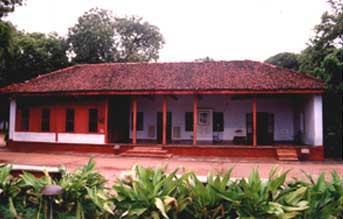| Destinations
|
|||
Ahmedabad Named after Sultan Ahmad Shah who founded it in 1411 AD, this city has developed into a leading industrial centre. The monuments are a synthesis of Muslim and Hindu forms brought about by the joint endeavour of Muslim Kings and Hindu artisans.
Places of Interest
Juma Masjid - Built of yellow sandstone this mosque stands on 260 pillars which support 15 domes at varying elevations, is situated in the centre of the old city. Shaking Minarets - These minarets are a part of the mosque of Siddi Bashir and can be swayed by applying a little force at the topmost arch. One of the minarets was partly demolished by an Englishman in his endeavours to unravel the mystery of the swaying minarets. Hathising Jain Temple - This Jain temple built of white marble and profusely carved is dedicated to Dharmanath - the 15th Jina or Jain Apostle. Bhadra Fort - Once housed royal palaces and beautiful gardens. It has the temple of Bhadrakali and was built in 1411 during the Maratha rule. |
More on Gujarat • Introduction • Saurashtra - Part I • Saurashtra - Part II • Gir Sanctuary
Travelogues
Leisure |
||
Kutbi Mazar - A colossal monument raised in the memory of Syedna Qutubuddin Shaheed, the high priest of the Bohra community.
Bhavnagar- The most flourishing port on the South Eastern coast of the Saurashtra region of Gujarat. Lothal - Located 87 kms from Ahmedabad, is a place of tremendous archaelogical significance. Excavations have uncovered a planned city of Harappan civilisation of the 2nd millennium B.C. with an intricate underground drainage system. An on site museum displays beads, bangles, painted bowls, goblets, jars, terra-cotta toys and ivory and shell objects which were unearthed during the excavations.Baroda Baroda or `Vadodara', the original name of Baroda means `set in the womb of the banyan trees'. This erstwhile capital of the Gaekwads is now a pleasant medium sized city with some interesting museums, art galleries, palaces and a famous University. The Baroda Museum and Art Gallery is set within the Sayaji Bagh Park which has a mini-railway encircling it. Another museum named after Maharajah Fatehsingh is worth a visit. Vadodara boasts of it's own unique step-well - the Naulakhi Well which can rival those from Ahmedabad. In the centre of Vadodara town is a huge lake. Champaner - 47 kms from Baroda with it's Jami Masjid and the Dabhoi Fort 29 kms South-East of Baroda and a fine example of Hindu military architecture can be easily covered as a day excursion from Vadodara. The Dakor Temple dedicated to Lord Krishna is a major centre for the Sharad-Purnima festival in October/November and is equidistant from Baroda and Ahmedabad.
|
|||
Editor: Romola Butalia (c) India Travelogue. All rights reserved. |
|||

 Sabarmati Ashram - Founded by Mahatma Gandhi in 1915, it continues the work started by him and has a handicrafts centre, a handmade paper factory and a spinning wheel factory. The cottage where Gandhiji lived is now a small museum displaying his few possessions.
Sabarmati Ashram - Founded by Mahatma Gandhi in 1915, it continues the work started by him and has a handicrafts centre, a handmade paper factory and a spinning wheel factory. The cottage where Gandhiji lived is now a small museum displaying his few possessions.